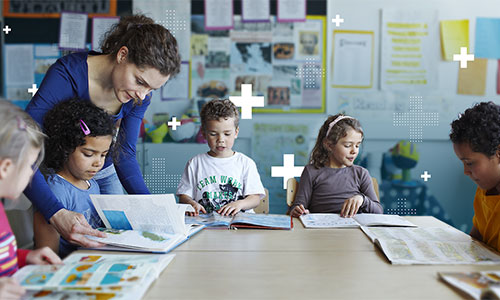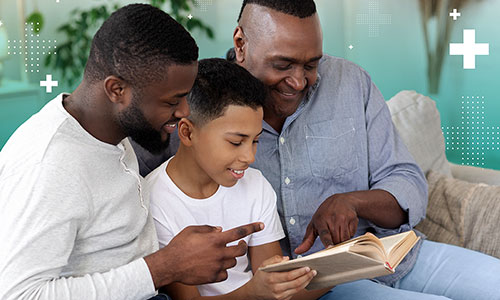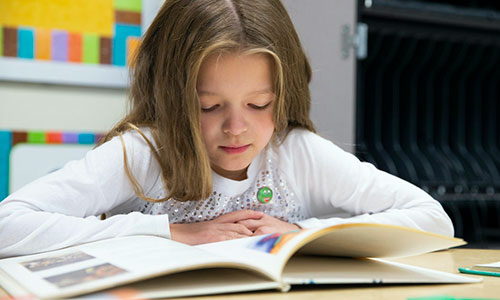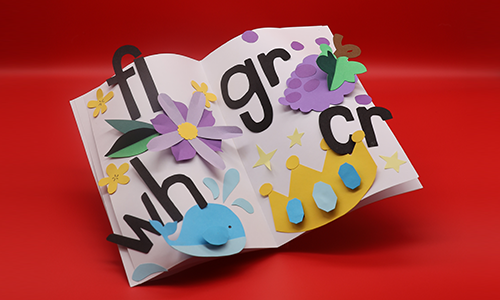
Last year, I read a parent’s post in a social media discussion about reading. They were seeking information on which schools in my town are teaching phonics only. This parent wanted nothing to do with all that “other stuff,” just phonics. Why? “Because that’s what the science of reading says works,” they argued.
That’s a problem. I’m all for the science of reading, but I’m not for the version that neglects some parts of it.
We can’t pick and choose and expect great reading results
Improving phonics and decoding instruction is a hugely important effort. But decoding isn’t the only thing that matters, and it isn’t the only area where research evidence can inform what works. A critical second piece of the puzzle is the topic of this post: language comprehension. Language comprehension is fundamental for literacy instruction, including for many emergent bilingual students.
Broadly, the science of reading is the converging evidence about what matters and what works in helping kids to read complex texts, including with good comprehension. One way to organize what matters for reading comprehension is through a model called the Simple View of Reading. It frames reading comprehension as the product of word recognition, which includes decoding and language comprehension: you can’t get to reading comprehension without fully developing each.
Decoding means kids can convert printed squiggles into the words we use in speech. But language comprehension means that kids can understand the meaning that those words convey. A child can show language comprehension without decoding, like when you read a book aloud to them. Eventually, we want kids doing both at once, so they can engage with meaning while processing those symbols themselves.
Even before kids can decode, though, we need to be building their language comprehension. This isn’t work that comes after decoding; it is work that starts in infancy and keeps deepening throughout our lives. Let’s take a closer look at what the science tells us about what matters and what works in developing language comprehension.
What matters in language comprehension?
Several components working together within language comprehension matter when building strong readers, and I’ll talk about three here: vocabulary, understanding of sentences and syntax, and knowledge.
A child’s oral language vocabulary includes the words they can use and understand in speaking and listening. They may not be able to decode or recognize them in writing yet, but they have some understanding of their meaning. Vocabulary knowledge is proven to support reading comprehension. In fact, broad vocabularies even help with word decoding by giving kids a way to confirm that what they sounded out is actually a word.
Knowing the meanings of words matters, but words live in sentences. That’s where syntax comes in. P. D. Q. Bach gives us a great example in a satirical Christmas carol. What starts off as a patient request—“Throw the yule log on, Uncle John”—becomes an exasperated call to arms: “Throw the yule log on Uncle John!” Differences in meaning are not always about the words. Handling the subtleties and complexities of syntax is important for understanding, and this starts even before kids are reading sentences for themselves.
Note that for emergent bilinguals, both vocabulary and sentence-level comprehension are developing in more than one language at once. That leads to an incredible advantage, and it leads there in ways that can differ from what is typical of monolingual development. No “science of reading” that only focuses on monolingual English development is going to suffice.
There’s one more piece that I mentioned mattering in language comprehension: knowledge. We gain knowledge from text, but we are also applying our own funds of knowledge to text. Knowledge helps us form an overall model of what a text is talking about, and it helps us to make inferences. This happens across sentences, not just within them.
Words matter, sentences matter, and the interaction of paragraphs with what the reader brings matters in strong reading comprehension. This is why research—focusing on both monolinguals and emergent bilinguals, of course—has delved into what works in helping grow students’ vocabularies, sentence-level understanding, and knowledge.
What works with our younger students?
Even before kids can read words, they are developing their future reading comprehension by developing their language comprehension. And this doesn’t just have to be in English. For an emergent bilingual, this is happening across languages as the child builds their full linguistic repertoire. Development in both languages helps bilinguals’ eventual reading comprehension, even when we zoom in on reading comprehension in English.
Let’s be really clear about that one: supporting development of a home language, too—Spanish, Somali, or whichever language it is—helps kids with English reading comprehension later.
In class, we can help language comprehension development in two key ways: through oral language and through written language.
The science points to the importance of lots of high-quality oral language interactions, both between teachers and students and between students themselves. When teachers invite, extend, and scaffold kids’ questions and their discussions, children’s engagement with learning grows. When classrooms set expectations that kids will be quiet or answer only simple questions, language growth is dampened.
Peer-to-peer talk is important, too. Thematic play centers, like the veterinary clinic or the grocer, offer opportunities for kids to use new vocabulary words—“appointment,” “surgery,” “vegetables,” “receipt”—and absorb new knowledge. (Some of your emergent bilingual kiddos will use a combination of languages, and even if you only know one, that should be welcomed.) Thematic units can also involve experiments, gardening, expert visitors, field trips, and of course books.
That brings us to a second key way that we can support language development: through sharing written language. Read alouds from books that children can’t read yet offer exposure to new words and more challenging language. Written language is more rich in vocabulary and syntax than what we tend to use in speaking, and it provides a way to stop and unpack words and pieces of knowledge that support inferencing. Even with second-graders who can read some books on their own, interactive read alouds are important for offering language at levels beyond what they can decode or understand independently.
Keep in mind that texts you use for growing literacy don’t have to be different from texts you use to teach content. Use of content-rich literacy instruction is a promising literacy practice: use books and passages about the science or social studies kids are learning this month. Be clear in planning for two outcomes: improving content knowledge and improving language and vocabulary.
Try it out
We want kids talking and listening with one another and with you, their teacher. Here are two practices to check out, each with a clear and comprehensive guide from The Meadows Center for Preventing Educational Risk in Texas:
- Turn and talk. Try making regular use of the routine described in this guide when teaching new content, even outside of your literacy block. Think about different pairings. Try pairing a child with less developed language comprehension with a peer who is further along. Try encouraging students with a shared home language to translanguage so that some of the words in their exchanges are in a language you may not speak.
- Read-aloud routine. Follow this approach when you do your next read aloud, to focus on building vocabulary and understanding from the text.
What works with our intermediate grade students?
When kids are a little older and have some decoding skills, developing language comprehension can include use of texts they read themselves. But that means it becomes important to account for students who have difficulty reading, too. More intensive small-group intervention is effective for these kids.
For many students who are struggling a bit, trouble involves an overlap between decoding and language comprehension. If a student struggles with language comprehension, decoding can be more difficult. Likewise, if a student struggles to decode, they read fewer words and, therefore, get less exposure to the vocabulary, syntax, and knowledge offered in written language. Interventions that are multifaceted and attuned to students’ needs are most effective at supporting reading comprehension. For students with emerging English language proficiency, plenty of support for oral language comprehension should surround any work on decoding.
In whole-class instruction, should we focus on vocabulary instruction? It is difficult to improve comprehension outcomes just by teaching vocabulary; there are just so many words out there. Choosing words to teach should attend to two questions: 1) Is the word present in this text we are reading, in meaningful ways? 2) Is it an academic content word that students are likely to encounter repeatedly in other texts?
Teaching key vocabulary words in a target text helps improve students’ comprehension of that text, but staying at a definition level is not enough. More effective practice gets kids engaged with thinking about the word more deeply. Unpacking a word’s uses, connecting it to other vocabulary, or using it in writing are examples of this more active processing. For emergent bilinguals, it can be helpful to draw attention to any cognates, that is, words with shared origin, such that spelling and meaning are close in the two languages. Stick with the words you teach for a few days, using different learning activities. Engage kids in talking to one another about the content you are teaching and listen for use of these new words.
Students may present as having a high level of proficiency in English, but there is always room for growth. Kids can be 100% proficient at navigating playground language while still developing their skills at more academic language. This isn’t just about vocabulary but syntax, too: when faced with the kind of complex sentence (ahem) that compounds, modifies, and then inserts a related thought, not all kids—monolingual or bilingual—are ready to fly on their own. What’s the takeaway? It’s important to offer scaffolding and support for vocabulary and sentence-level syntax in all whole-class instruction. Just make it regular practice. Provide the support so that anyone who needs it is given access to new content knowledge all the time.
Try it out
Here are a couple useful resources that can help you focus on building language comprehension with older students:
- Teaching academic content and literacy to English learners in elementary and middle school. You know what’s great about practices that support emergent bilinguals? They help all kids, even those growing up learning only English. You know what else is great about this What Works Clearinghouse guide? It enlists all teachers, not just the reading ones. Plus, it comes with a short video!
- Turn and talk. This one (yep, same strategy as with little kids) is worth a second posting here. We have to stop letting instruction look like a teacher talking and students not talking. Instead, language development must be active, with voices and identities of students being invited and valued.
Learn more
To learn more about the science of reading, download our eBook Everything you need to know about the science of reading. For information on using the MAP® Reading Fluency™ assessment to evaluate a student’s reading skills, visit our website.




